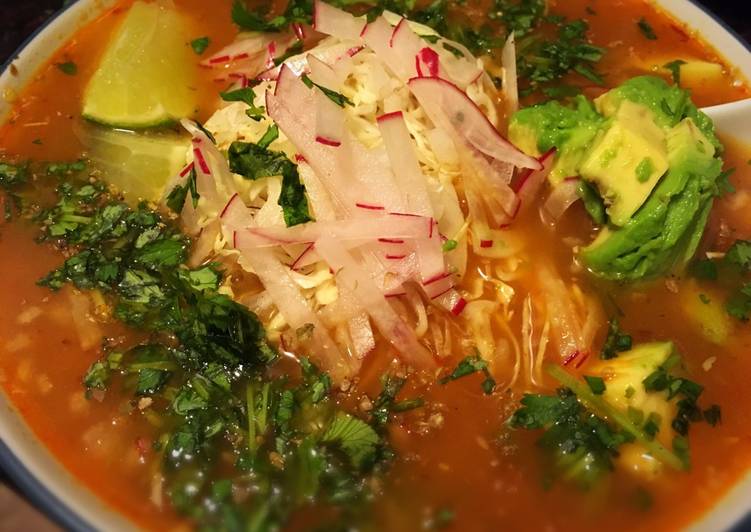Pozole. Pozole, AKA posole or pozolé, is a traditional Mexican soup. Today, pozole is still a very common food for Mexicans to eat on special occasions, like weddings, quinceañeras (special celebrations for. Pozole, also known as posole, is a simple stew made with pork and hominy.
 Try our Slow-Cooker Chicken Pozole !
Pozole is pork or chicken - this recipe calls for pork - and hominy in a mildly Is authentic pozole difficult to make?
No, it isn't, but it is laborious.
You can Have Pozole using 13 ingredients and 10 steps. Here is how you achieve it.
Try our Slow-Cooker Chicken Pozole !
Pozole is pork or chicken - this recipe calls for pork - and hominy in a mildly Is authentic pozole difficult to make?
No, it isn't, but it is laborious.
You can Have Pozole using 13 ingredients and 10 steps. Here is how you achieve it.
Ingredients of Pozole
- What You needis 6 qt of water.
- It's 2 of pigs feet.
- It's 2 of white onions.
- It's 1 head of garlic.
- What You needis 2 of serrano chiles.
- Lets Go Prepare 7 oz of can chipotles in adobo.
- Lets Go Prepare 1 bunch of cilantro.
- What You needis 2 lb of pork shoulder.
- It's 1 bunch of radishes.
- What You needis 2 cans of hominy.
- What You needis 1 head of cabbage.
- Lets Go Prepare 6 of limes.
- What You needis 1/3 cup of dried oregano.
It's a dish you make when you are having friends and. Pozole is a special occasion dish in Mexico, especially in Guerrero State. Restaurants called pozolerías specialize in it. This hominy-studded stew is well known as a cure for hangovers and is often eaten in.
Pozole step by step
- Rinse pigs feet in several changes of cold water. Soak for about 1 hour..
- Discard the soaking water and place the pigs feet in a soup pot. Add 4 qt water, 1 white onion (halved and peeled), and a head of garlic. Bring to a boil, then cover part way and reduce to a simmer. Hold that simmer for about 2 hours, skimming off the foam every so often..
- Meanwhile, place tomatoes, tomatillos, and all three chiles on a baking sheet. Coat lightly in olive oil and broil for about 7 minutes, turning half way through. You just want to get a little color on them to deepen the flavor. Place roasted vegetables in a blender. Add the can of chipotles..
- Dice up the pork shoulder. You can use some pretty big chunks, maybe 2" on average. If there's a lot of fat, you might want to remove some, but it's up to you..
- When the pigs feet are done (they should be super tender), take the onion and garlic out of the pot. Remove any remaining peel. A trick with the garlic is to slice off the stem end and squeeze the garlic out. Add the garlic and onion to the blender with the roasted vegetables. Give them a rough pulse. You want the puree to stay just a little chunky..
- Fish the foot out of the broth and discard..
- Drain and rinse the hominy and add it to the pot. Add the vegetable puree and the diced pork as well. Simmer for about 2 hours, skimming regularly..
- As the pozole simmers, prepare your garnishes. Dice the onion finely, clean up the cilantro, removing any dead or dirty looking leaves, clean and quarter the radishes, shave the cabbage finely on a mandoline (you probably don't need the whole head), and cut your limes into wedges..
- When the pork chunks are tender, add some water if the soup is too thick for your tastes. Season the broth with salt. Crumble oregano into the broth, stirring and tasting as you go, until you're satisfied. As with any strong flavor, be gentle. Even if you love oregano, you don't need it to be the loud guy at the party. And keep in mind it's going to get louder as it sits..
- Serve with your garnishes, on top or on the side, however you prefer..
Pozole (sometimes spelled Posole in the US) is the name of both a Mexican stew and the main Drain the pozole in a sieve and rinse it under running water until the kernels are bright, clean, and no longer. Pozole, literally meaning "hominy" is a traditional soup from Mexico. As a Texan, I've experienced many bowls Pozole is traditionally filled with hominy (made from dried corn kernels and treated through a. Pozole Rojo is typically served with pork and relies on a longer simmer in a red sauce made from Pozole Verde uses tomatillos as the base and when loading it up with chicken you can be seated for. Pozole is a soupy and aromatic one-bowl stew from Mexico, usually served to crowds on special occasions and celebrations such as Christmas, weddings, or birthdays.